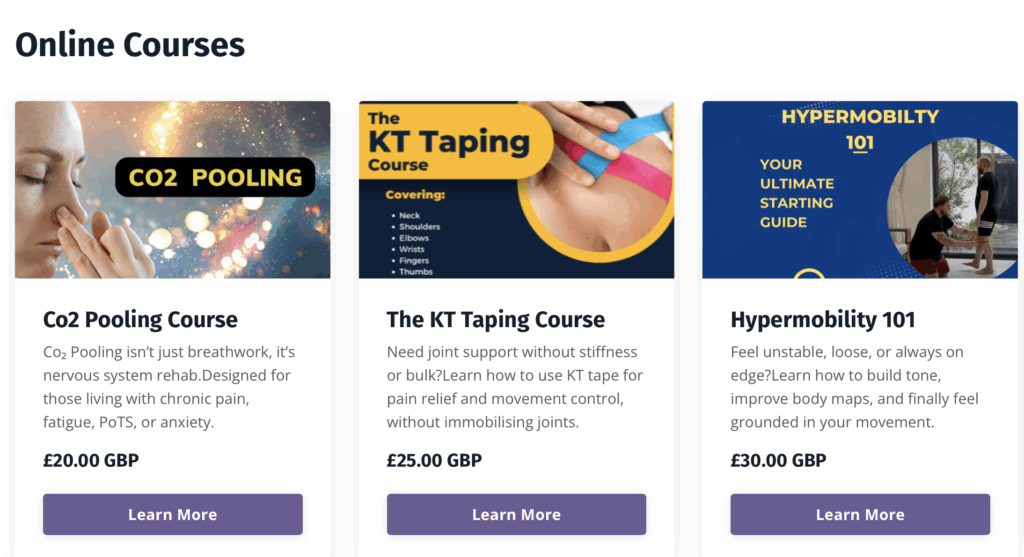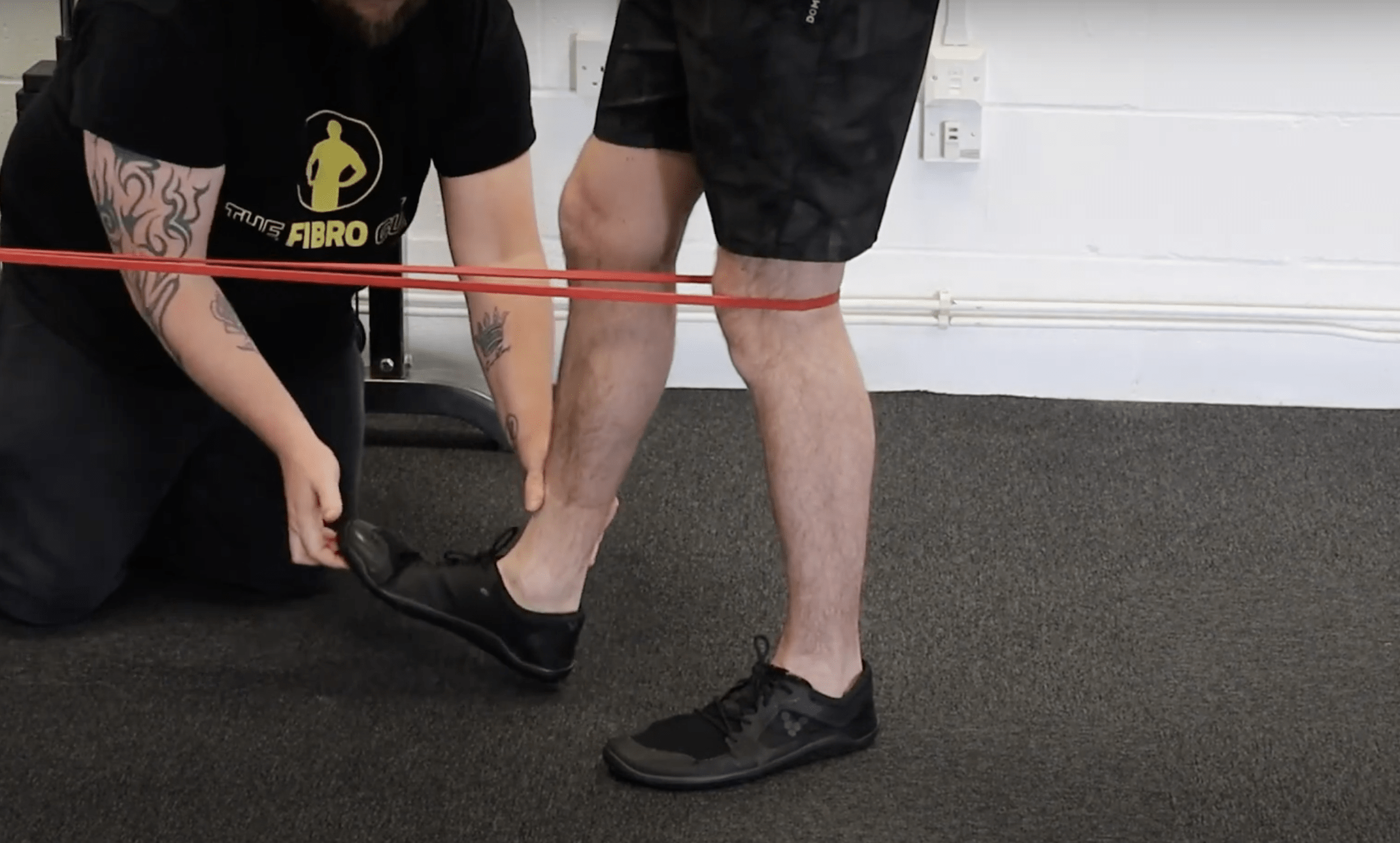- POTS and Exercise: The First Step Everyone Misses - 27 June 2025
- The Missing Link Between Breathlessness, Fatigue, and Chronic Pain: Understanding CO₂ Tolerance - 19 June 2025
- What is Mast Cell Activation Syndrome? - 12 May 2025
I’ve worked with knee instability and pain for a very long time, and I find that people, generally, have so many complaints with the specific knee exercises that are targeted to those with hypermobility and Ehlers Danlos syndrome that other practitioners seem to push. A quick YouTube search and you’re presented with a plethora of exercises and advice from people with no proof to the pudding as they say, all given the same mundane and inaccurate advice. And what irritates me the most as a practitioner who has spent years working with hypermobile clients to stabiles their knees, is that all of the exercise out there are built on a fundamentally flawed and outdated approach to knee stability.
One fraught with gaslighting for those with hypermobility, when these exercises enviably don’t help to stabiles their knees, or resolve knee pain, and then they get palmed off with the old “you didn’t try hard enough” excuse. Which, sadly, a quick search on social media will return that this seems to be a very common theme.
So, let’s use this article to look at why the traditional “build muscle” approach isn’t working, where instability and pain comes from, and what we can do about it.
Muscle Building: An Old Perspective
For decades now, emphasis has always been placed on building muscle to help support lax hypermobile joints through exercise, however, if you stop to think for just a moment, this perspective starts to break down fairly fast. There are no shortages in magazine articles or indeed people, who push the agenda of “just build muscle to help support the joint”. Whilst this is not a bad idea, it does have several flaws.
Firstly, building muscle takes a little while and there is a debate of how much muscle individuals can gain, as it depends on several factors including genetics, training intensity, consistency, diet, age, and gender. For men, the potential muscle gain in the first year of dedicated training can range from 15 to 25 pounds, with the possibility of adding another 10 to 15 pounds in the second year. For women, the expected gains are about half of that for men, with 8 to 12 pounds in the first year and another 4 to 6 pounds in the second year.
But, again, this will vary wildly person to person, and surprise, surprise, to date there have been no studies that look into this for the hypermobile population, but it is widely medically accepted that muscle strength can help to support joint stability. So then, my first issue here is “How much muscle does someone with hypermobility need to build to stabilise a joint?”
Obviously, there is no answer, because in the grand scheme of things it not particularly important. There are many with hypermobility who have lots of musculature who repeatedly dislocate their joints, and many with much less musculature who don’t dislocate at all. The muscle-to-dislocation ratio just doesn’t correlate.
Likewise, for structures like the Sacroiliac (SI) joint, there are no muscles that directly span it, only several muscles and ligaments provide support and stability to this area. So then, how is building muscle going to help?
Secondly, building muscle has a few prerequisites. You need good nutrition, which should be rich in protein to support muscle repair and growth, as well as balanced with carbohydrates for energy and healthy fats for overall well-being. Adequate hydration is essential to support all bodily functions, including muscle recovery and growth. And consistency in training, with a focus on progressive overload of weight, is also necessary to continually challenge the muscles and stimulate growth.
But it is this last point that causes some issues!
How can one who is suffering from joint subluxations/dislocations, be consistent at lifting heavier and heavier weight when the joints are already unstable and recurrent injuries are ever prevalent?
This contradiction has always been there and is indeed a significant hurdle in managing hypermobility through just muscle strengthening alone. Obviously, some may argue that the weights don’t need to be that heavy, however, muscles only respond to progressive and consistent stress, and if you use weight that is not challenging then it simply won’t lead to muscle building.
For those with hypermobility, who don’t subluxate or dislocate, then muscle building and strengthening exercises are likely going to help, it is just the folks who are somewhat laxer, who may encounter problems with this approach. And with working with the hypermobile population for as long as I have, this is a story I have heard time and time again.
When you stop to think about it, this advice seems a little flawed and doesn’t make much sense when you start to drill into it.
This article covers:
ToggleCauses of Knee Pain in EDS and Hypermobility
Joint Instability: One of the most prevalent challenges faced by individuals with Ehlers-Danlos Syndrome (EDS) is the significant joint instability that often accompanies the condition. In weight-bearing joints such as the knees, this instability can frequently lead to painful subluxations or even full dislocations, where the joint partially or completely shifts out of place. The result is not just physical discomfort but a daily struggle with unpredictability, as the knees may falter under the body’s weight, making even simple movements a source of unease and pain.
Collagen Defects: The very foundation of EDS lies in a genetic defect that affects collagen – the essential protein that provides strength and structure to connective tissues throughout the body. Collagen, in its normal function, offers the resilience needed to keep joints stable and secure. However, when its synthesis or structure is compromised, as is the case in those with EDS, the connective tissues lose their ability to provide adequate support. This lack of proper joint reinforcement leaves the knees particularly vulnerable to strain, further increasing the likelihood of pain and weakness.
Chronic Pain Syndromes: Pain in EDS doesn’t solely stem from mechanical issues like joint instability; it often extends far beyond that, deeply rooted in the complexities of the nervous system. Many individuals with EDS endure chronic pain syndromes, which are believed to arise not only from the physical challenges of joint misalignment but also from abnormalities within the nervous system itself. Research suggests that in certain types of EDS, there is a decreased density of nerve fibres in the skin, coupled with functional nervous system irregularities. These neurological factors may amplify the sensation of pain, making it a persistent companion for many living with the condition.
Muscle Deconditioning: It is only natural that when movement becomes synonymous with pain, physical activity is often reduced or avoided altogether. Unfortunately, this avoidance leads to muscle deconditioning, where the muscles surrounding the joints lose strength and tone over time. For individuals with EDS, this muscle weakness exacerbates joint instability, creating a vicious cycle in which weakened muscles provide even less support for already unstable joints, leading to an increased risk of injury and, consequently, more pain.
Cortical Maps and Knee Instability
When understanding knee instability and weakness in hypermobility syndromes such as Ehlers-Danlos syndrome (EDS), the concept of cortical maps, also known as somatosensory maps, is a crucial piece of the puzzle. These cortical maps play a vital role in how our brain perceives the position and movement of our joints, and any distortion of these maps can lead to an increased risk of joint instability, such as knee instability in hypermobility.
What Are Cortical Maps?
Cortical maps are neural representations of your body parts within the brain, specifically in the primary motor and somatosensory cortices. These maps are responsible for processing sensory input from your body and coordinating motor actions. They help the brain understand the position and movement of various body parts, a sensory ability known as proprioception.
How Cortical Maps Influence Knee Stability
In the context of knee stability, an accurate cortical map of the knee allows for precise coordination of movements and effective stabilization of the knee joint during various activities such as walking, running, or climbing stairs.

However, in individuals with hypermobility, these cortical maps can become distorted or “smudged.” This distortion can occur due to repetitive subluxations or dislocations and the resulting inflammation common in hypermobility. The barrage of nociceptive signals, essentially pain or harm signals, sent to the brain during these episodes can interfere with the brain’s accurate representation of the knee joint.
Think of this like an old television receiving a fuzzy signal. The more interference, or “noise,” there is, the harder it is for the brain to accurately perceive the position and movement of the knee joint.
Cortical Smudging and Knee Instability
This cortical smudging can contribute to knee instability and weakness in several ways. With a distorted picture of where the knee is and how it’s moving, the brain might have trouble coordinating the precise movements needed to stabilize the knee. This could lead to a knee that feels weak or unstable, potentially “giving way” during movement.
Furthermore, as the brain prioritizes nociceptive signals following a subluxation or dislocation, the lowered threshold for these pain signals can further contribute to the instability. The brain might interpret normal movements as potentially harmful, leading to protective responses that could further destabilize the knee joint.
Now this whole topic can get rather complicated, rather quickly, so if it is something you would like to read into, I wrote a 10,000 word article on it here.
People generally have some issues with the specific hypermobility knee exercises that are currently out there. They either don’t work or they yield very little results. This is largely due to the simple fact that the current treatment around exercises for those with hypermobility, are built on a false premise and simply do not take into account the nuances that come with this population.
The gold standard at the moment for hypermobile knee exercises, and indeed any exercise for those with hypermobility, seems to be the old “build muscle around the joint to help stabilise it” approach.
This old outdated approach that has seen many hypermobile people simply lose interest in, after seeing it return such little results, comes with 2 main issues. Issues that most people don’t really talk about.
- Building muscle requires sufficient load and consistency to do so. How is anyone with unstable joints supposed to use such load required to build muscle and not get injured?
- Muscle gains are slow. If we use women as an example, and whilst ensuring that training and diet are on point, we could expect to see around a 10lb gain in muscle mass over the course of a year. However, there are no studies that follow muscle gain in those with hypermobility. So how much muscle are we supposed to add to create stable joints: 5lb, 25lb? and how are we supposed to even add muscle tissue when we can’t handle the load required to build muscles in the first place?
There are also other issues, such as why do women with high muscle mass still dislocate, whilst others with less muscle mass dislocate less?
The current treatment seems to fall apart somewhat when we start to question it. No wonder this current treatment has caused so much distress and gaslighting to those with hypermobility when it doesn’t even make any sense. We have seen so many people in the studio who have all reported the same thing, they did their physio, it didn’t work, and they were blamed for not trying hard enough.
What’s needed in a hypermobile knee exercise?
In order to stabilise a joint, a few key points need to be met:
- You need a tactile cue to light up the areas of the brain dedicated to the knee (Like KT tape or a band), in order to connect to the tissue.
- The load needs to be used in a closed chain fashion.
- Specific mapping techniques need to be used to detail those cortical maps and give control over the joint again.
- Load needs to be increased over time to ensure tissue tolerance goes up.
- And for detailing of the cortical maps for long term (tactile cues are only temporary) you need coding pattern techniques (chat to one of the team)
Many people have used many different forms of exercise to help stabilises hypermobile knees, and whilst we often see swimming or hydrotherapy as a form of great exercise, please remember there are issues with these.
We live on land and we need to be able to deal with the various forces that enact upon us. Whilst swimming can be a great form of cardiovascular exercise, it is not doing a great deal in the form of stabilising our joints, and it takes away the loading forces that will help up in the long run, which can decondition us further.
There is also an issue with the use of hydrotherapy, those 39-degree waters will vasodilate our blood vessels, forcing our hearts to work harder to pump blood around, as well as causing blood pooling, potentially making us dizzy and faint. Which is not want we want when we are in a large body of water.
Load is a crucial part of stabilising joints, however, it needs to be the right form of load. Open chain exercises such as the leg extension machine you would find at any gym, are a good example of bad load, putting large leverage forces through tissue, which those of us with hypermobility can not properly handle(yet).
A good hypermobile knee exercise needs to be transferable to everyday life, meaning the benefits of it cross over to other movements and other activities.
How to do the hypermobility knee exercise in the video
There seems to be much demand for a simple and effective hypermobility knee exercise. So, below you can find one of our favourite hypermobility knee exercises, which is aimed at helping those with hypermobility and Ehlers-Danlos syndrome, by addressing some of the real issues that need to be addressed.
Keep in mind, that a large problem with hypermobility exercises, in general, is that individuals tend to have trouble contracting the right tissues or even feeling the muscle they are exercising in the first place. This is why a tactile cue, used with a closed chain exercise, is a great way to train the tissue and your brain, in an exercise that is transferable to everyday life.
For this type of exercise, it is far better to use time, rather than sets and repetitions. You can start off performing this exercise for up to 1 minute twice per day, and spend the next 3 weeks trying to get up to a total of 4 minutes.
Enjoy!
– Adam –
Enjoyed Our Blog? Why Stop Here?
If you’ve found value in our posts, imagine what you’ll gain from a structured, science-backed course designed just for you. Hypermobility 101 is your ultimate starting point for building strength, stability, and confidence in your body.






